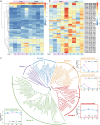Phytosulfokine contributes to suspension culture of Cunninghamia lanceolata through its impact on redox homeostasis
- PMID: 37814230
- PMCID: PMC10561472
- DOI: 10.1186/s12870-023-04496-1
Phytosulfokine contributes to suspension culture of Cunninghamia lanceolata through its impact on redox homeostasis
Abstract
Background: Suspension culture is widely used in the establishment of efficient plant regeneration systems, as well as in the mass production of plant secondary metabolites. However, the establishment of a suspension culture system of Cunninghamia lanceolata is genotype-dependent given that proembryogenic masses (PEMs) are prone to browning during this process in recalcitrant genotypes. Previously, we reported that the plant peptide hormone phytosulfokine (PSK) can tremendously decrease the hydrogen peroxide (H2O2) level and help to initiate somatic embryogenesis (SE) in recalcitrant C. lanceolata genotypes. However, to date, no studies have revealed whether or how PSK may contribute to the establishment of a suspension culture system in these recalcitrant genotypes.
Results: Here, we demonstrated that exogenous application of PSK effectively inhibited PEM browning during suspension culture in a recalcitrant genotype of C. lanceolata. Comparative time-series transcriptome profiling showed that redox homeostasis underwent drastic fluctuations when PEMs were cultured in liquid medium, while additional PSK treatment helped to maintain a relatively stable redox homeostasis. Interestingly, PSK seemed to have a dual effect on peroxidases (PRXs), with PSK simultaneously transcriptionally repressing ROS-producing PRXs and activating ROS-scavenging PRXs. Furthermore, determination of H2O2 and MDA content, as well as cell viability, showed that exogenous PSK treatment inhibited PEM browning and safeguarded PEM suspension culture by decreasing the H2O2 level and increasing PEM activity.
Conclusions: Collectively, these findings provide a valuable tool for the future establishment of large-scale C. lanceolata PEM suspension culture without genotype limitations.
Keywords: Bowning; C. lanceolate; PSK; ROS; Suspension culture.
© 2023. BioMed Central Ltd., part of Springer Nature.
Conflict of interest statement
The authors declare no competing interests.
Figures






References
-
- Steward FC, Mapes MO, Smith J. Growth and organized development of cultured cells I. growth and division of freely suspended cells. Am J Bot. 1958;45:693–703.
-
- Loyola-Vargas VM, Ochoa-Alejo N. Somatic Embryogenesis: Fundamental Aspects and Applications. Switzerland: Springer; 2016.
-
- Ramirez-Mosqueda MA: Overview of Somatic Embryogenesis. In: Somatic Embryogenesis. Edited by Ramírez-Mosqueda MA. New York, NY: Humana; 2022.
-
- von Arnold S, Sabala I, Bozhkov P, Dyachok J, Filonova L. Developmental pathways of somatic embryogenesis. Plant Cell Tiss Org. 2002;69:233–249.
MeSH terms
Substances
Grants and funding
- BK20210614/Youth Foundation of the Natural Science Foundation of Jiangsu Province
- 202110298005Z/Higher School in Jiangsu Province College Students' Practice Innovation Training Programs
- 202110298005Z/Higher School in Jiangsu Province College Students' Practice Innovation Training Programs
- 202110298005Z/Higher School in Jiangsu Province College Students' Practice Innovation Training Programs
- 2020R1009003/Fujian Provincial Public-interest Scientific Institution Basal Research Fund
LinkOut - more resources
Full Text Sources
Research Materials
Miscellaneous

